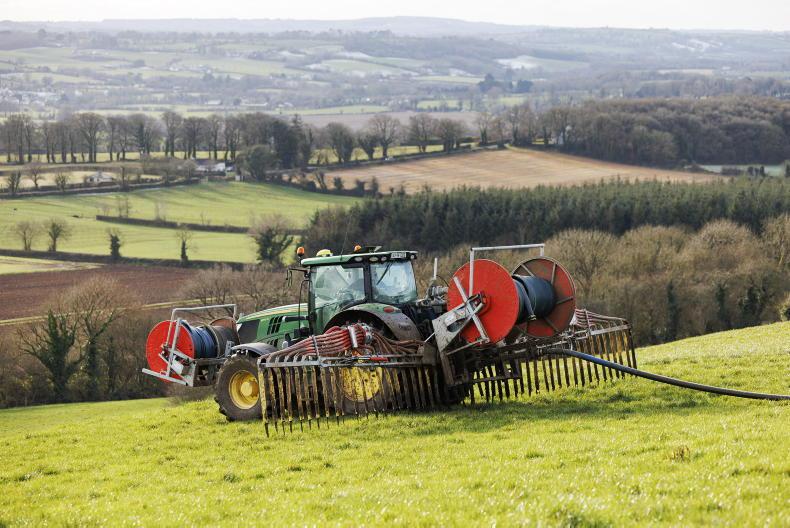Minister for Agriculture Charlie McConalogue is to impose a four-day timeframe for farmers reporting manure movement between farms.
The move is an effort to clamp down on bogus or ‘paper’ exports of slurry, where physical exports do not happen but are recorded by farmers to stay within the nitrates rules.
Announcing the new rule, Minister McConalogue said the four-day timeframe would “allow inspection on the ground to verify slurry movements”.
“This will be rolled out in the coming weeks, allowing farmers sufficient time to declare any movements of manure that have already taken place in 2024,” he said.
Excretion rates
Following Thursday’s meeting of the Agriculture Water Quality Group, Minister McConalogue said he was bringing forward a number of other changes, including adjustments to nitrogen excretion values for calves and cows, following scientific work carried out by Teagasc.
“Last October, my Department requested that Teagasc undertake research regarding bovine nutrient excretion rates. This included consideration of the excretion rate of young bovines and the impact that reducing crude protein in concentrates fed to dairy cows has on the cow's nutrient excretion rate.
“This work confirmed that excretion rates for young calves is lower than previously estimated, and that dairy farmers can reduce their cows’ nutrient excretion rate by limiting the level of crude protein in concentrate feed.”
The current annual excretion rate of 24kg of nitrogen for the zero to one-year-old animal will be updated to reflect two sub-categories the calf aged zero to three months, and cattle aged four to 12 months.
The nutrient excretion rate for cattle aged one to two will be amended to 55kg in respect of females, and 61kg in respect of males, reflecting most recent scientific work.
Chemical nitrogen limit
The review of the Nitrates Action Plan will also propose a reduction in the maximum chemical allowance for grassland.
No information was published by the Department on the proposed chemical nitrogen ceiling.
It's understood that the Department working group has recommended a 5% cut, while the Nitrates Expert Group has recommended a 10% cut to the existing chemical nitrogen limits.
Read more
GPS trackers to clamp down on bogus slurry exports
Minister for Agriculture Charlie McConalogue is to impose a four-day timeframe for farmers reporting manure movement between farms.
The move is an effort to clamp down on bogus or ‘paper’ exports of slurry, where physical exports do not happen but are recorded by farmers to stay within the nitrates rules.
Announcing the new rule, Minister McConalogue said the four-day timeframe would “allow inspection on the ground to verify slurry movements”.
“This will be rolled out in the coming weeks, allowing farmers sufficient time to declare any movements of manure that have already taken place in 2024,” he said.
Excretion rates
Following Thursday’s meeting of the Agriculture Water Quality Group, Minister McConalogue said he was bringing forward a number of other changes, including adjustments to nitrogen excretion values for calves and cows, following scientific work carried out by Teagasc.
“Last October, my Department requested that Teagasc undertake research regarding bovine nutrient excretion rates. This included consideration of the excretion rate of young bovines and the impact that reducing crude protein in concentrates fed to dairy cows has on the cow's nutrient excretion rate.
“This work confirmed that excretion rates for young calves is lower than previously estimated, and that dairy farmers can reduce their cows’ nutrient excretion rate by limiting the level of crude protein in concentrate feed.”
The current annual excretion rate of 24kg of nitrogen for the zero to one-year-old animal will be updated to reflect two sub-categories the calf aged zero to three months, and cattle aged four to 12 months.
The nutrient excretion rate for cattle aged one to two will be amended to 55kg in respect of females, and 61kg in respect of males, reflecting most recent scientific work.
Chemical nitrogen limit
The review of the Nitrates Action Plan will also propose a reduction in the maximum chemical allowance for grassland.
No information was published by the Department on the proposed chemical nitrogen ceiling.
It's understood that the Department working group has recommended a 5% cut, while the Nitrates Expert Group has recommended a 10% cut to the existing chemical nitrogen limits.
Read more
GPS trackers to clamp down on bogus slurry exports






 This is a subscriber-only article
This is a subscriber-only article











SHARING OPTIONS: